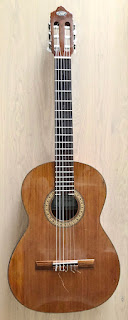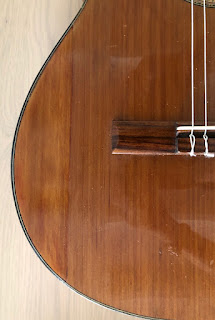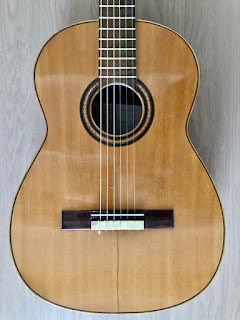

BEFORE and AFTER
First there was a lot of confusion around this guitar:
Should the label read Juan Cortes or José Cortes?
Looking at the tuners it had to be an older guitar and
most likely in the neighnourhood of Valencia and
not Madrid as the so called Juan Cortes guitars are
saying to come from. The Juan Cortes guitars were
possibly produced by Jose Mas y Mas, a big guitar
factory in Valencia. The name is in fact even a fake
name, given by the Dutch importer van der Wouw.
He imported student quality guitars from the sixties
onwards and even numbered them.
When you look closely at the back, you will notice
that the back seems to been made out of one piece of
wood but simply double control from the inside learns
otherwise. What is obvious here is the more rounded
heel model a lot of Valencia luthiers built in the
first half of the past century is there.
Here the label in this guitar has been photographed but
for some reason the lower right part has been sticked off
with a piece of paper. Luckily the Spanish guitar from the
same luthier / dealer used by Koos Speenhoff carries the
complete label: It says: "Manufactura de Guitarras / e
Instrumentos Similares / J. Cortés / Continuacion
de Jorje Juan, D.N. / Valencia / (Espana)"
The Koos Speenhoff guitar he used can be dated between
1920 - 1930. The son of Jose Cortes ended his business in
1932 so it could be quite reliable.
The Koos Speenhoff guitar is a little more deluxe than
the guitar I'm restoring now. Ton Bogaard from the
guitarrasvalencia.wordpress site did a lot of investi-
gations around the luthiers and factories in and around
Valencia. He is always a very useful source around
these instruments. He examined the guitar of Koos
Speenhoff and declares that the instrument is not
playable nowadays. As a restorer I can immediately
conclude that due to the tension the section of the
soundboard left and right from the fingerboard dis-
torted as a result. This is often the case on older
guitars. The rosette is a bit more deluxe but I
can't conclude the soundboard to be quarter sawn
and most likely: Copper fretwork.
A bit surprising is the rather modern look of the back.
The outer heelcovering is part of the wood for the back.
The own frequency of the soundbox(where it resonates
the most) is B so 123,5 Hz.
BEFORE and AFTER
The bridge seems to be placed in an angle. A method
to get a sort of compensation for the octave pitch as was
common in the first half of the past century. In earlier
times there was no built in compensation at all and
only later in time the bridgebone was placed under
an angle.
A close picture from the bridge that clearly shows us
that the edges were more square as opposed to the later
more rounded edges on a bridge nowadays.
The "bulbed" headform can be seen here. But it is
not pointing towards a certain factory alas. Interesting
to see however that an even older Jose Cortes guitar
advertised on the Reverb site has the same headform
and the more rounded outer heel end but another
label has been used for that 1892 (?) dated guitar.
Probably and until now the oldest label of this
luthier / dealer from Valencia.
The rounded heel as was quite popular until 1940 on the
Telesforo Julve guitars. We have to be wide oriented as the
possibility is there that Julve is responsible for this
guitar. The heel made out of spruce is a method to speed
up production as it is a softer and more easy to adapt
kind of wood. On more expensive models this method
mostly isn't there.
The first move was to remove the bridge as it was badly
glued to the top. Then the brittle lacquer has been removed
which can be done while removing a minimum of the wood
itself. Here the neck to body angle has also already been
changed by shaving off the fingerboard towards the
head after having removed the original copper frets.
This guitar is only provided with a ladder bracing as were
a lot of student level guitars in those times. And also after-
wards a lot of simple guitars were only equipped with a
ladder bracing. To avoid warpage of the soundboard, it
was often bowed a bit to resist string tension. In this case
they've opted for a clever solution: They "bowed" the bridge
slightly and as it has been made out of hardwood it sets
the top, once glued onto it, thus giving more strength
against the tension of the strings.
As there were some deep carvings in the neck I decided to
strip the whole guitar. Spots from a strange liquid have
been removed as well.
Almost giving the idea that the back has been made out
of one piece of wood but in fact not.
Actually the first move was to repair the head as on
the left the wood cracked due to metal strings and
a much too high installed pitch.
In fact only visible from the back as the front of the
head had a veneer layer that was OK. On the side
the tuners will cover the seam visible there.
While working on this guitar the wood appeared to be a bit
weak so I figured not to use a weaker piece of wood with
the right color but a more sturdy piece of wood.
I've matched the top of the fingerboard with the rather
dark brown color of the sides, visible here. And already
in those times the softer spruce heel is fitted in order to
speed up the process of building a guitar.
Most likely these guitar sides weren't formed in a mold
but by hand on a piece of bowing iron, hence the traces
of the folding on one side.
Story around José Cortés Martinez
José Cortés Martinez (for his friends “Pepito”)
was a study mate and friend of Juan Ponce Parres
in Valencia. After José married, he lived for some
time in Paris (from the end of 1904 till the start of
1905) In Paris he took care as representative for
France and Germany on behalf of Juan Ponce. He
represented the companies “Vicente Parres”,
“Parres y Compañia” and “Juan Ponce”. During
1912 he moved to Hamburg (Möncke-bergstrasze-
12) together with his wife and his son and daughter.
This move made it possible for him to enlarge his
sales area in Germany, Poland, Denmark and the
Netherlands. Via the sales channels of José, Juan
Ponce sold his instruments with great success.
For unknown reasons the friendship between Cortés
and Ponce deteriorated during the years. The relation
derailed in 1917 when José Cortés claimed a high
amount of money as commission on all of his sales in
the countries mentioned. The real reason could be
that his own(!) instruments could not keep up with
price and quality of Juan Ponce’s. Juan Ponce stopped
all contacts with José in view of this claim and also
because of the unfolding of international problems
coming from World War 1. No notes nor letters are
found after this event in the archive of Juan Ponce /
Parres. (The export of Juan Ponce to afore mentioned
countries minimalized from that point).
(translated text of Enrique Santiago)
José Cortés Pardo (son?) continued the business in 1929,
working at the Platanas, 11 in Benicalap.2) In 1929 and
1930 José Cortés Pardo is registered at the Calle Pintor
Vilar 2743) The business was dicontinued in july1932.
Juan Cortes
Een Juan Cortes gitaar uit de Serie de Lujo. Het begint
bij deze gelabelde gitaren doorgaans met modellen met
een simpele "ladder" bracing en een rozet bestaande uit
concentrische cirkels. Dit instrument heeft een waaier
van 3 balkjes en een wat verder uitgewerkte rozet en kop.
Het bekende witte label met de rode letters en een inge-
stanst productienummer. Wellicht door de importeur
van der Wouw (Amsterdam) destijds gedaan. Scale:
645 mm. Breedte hals bij topkam: 52 mm. SOLD.
Mede vanwege een centrale balk die over de naad van het
bovenblad loopt is besloten de naad die wat open is gaan
staan, te vullen met lijm omdat de balk genoeg stabiliteit
geeft aan deze verbinding. Een simpele inzet is mogelijk
en ook geen probleem maar gewoon niet nodig.
De kam is voorzien van een 12 gaats systeem. Dat maakt
het verwisselen van snaren veel gemakkelijker maar zorgt
tevens voor een betere hoek over het eveneens nieuwe
kambeentje. Het snarenblok is standaard bij dit model:
extra versierd met een pearloid fineerlaag.
Wat lichte peutjes in de hals van het slordig wegzetten
maar de achterkant is, zeker gezien de leeftijd van deze
gitaar, nog heel fraai.
Dit detail is hier weergegeven vanwege de tekening
in het hout van een soort van dierenkop (giraffe?)
En de achterkant in zijn totaal welke opvallend
gaaf is qua uiterlijk.
De topkam is bijgevijld en op de optimale snaar-
hoogte gebracht. Nieuwe mechanieken.
Ook de frets hebben een opknapbeurt ondergaan:
Netjes rond en glad gemaakt. (Gepolijst)
Even lastig om te vinden: De mechanieken
die een beetje op dit soort gitaren horen.
Ook de kop is nog netjes en vrij van beschadigingen.
En een hak constructie welke geheel uit hardhout vervaardigd
is. Bij de meeste Cortes modellen is dat zo en daardoor weer
wat minder verwijzend naar Valencia als "geboortestad'.

Het lijkt een later bewerkte kop te zijn maar
dat is niet het geval. Het hoort zo.

De vorm van de kop is net wat 'ingewikkelder". De topkam
zowel als het kambeentje zijn uit echt been gemaakt maar
is wel opnieuw "gesoigneerd" want de topkam had nogal wat
scherpe kanten en te diepe gleuven. De toets wordt bij deze
producent vaak gevernist en gemakshalve worden de frets dan
meegenomen wat resulteert in een ongelijk fretoppervlak met
alle vervelende gevolgen van dien door de deels afspringende
vernislaag. Het fretwerk is nu rond, gevlakt en gepolijst.

Een lage kam is in principe prima maar vaak ook een teken
van een door de jaren heen "gegroeide" foute hoek die
de hals maakt met de klankkast. Voordeel bij dit exem-
plaar was de plaatsing van laag geplaatste gaatjes voor de
snaren in het snarenblok. Toch een twaalfgaats kam ge-
maakt waardoor de snaren een goede hoek over het
eveneens vernieuwde kambeentje maken.

Simpele mechanieken werden wel steeds op de verschillende
modellen toegepast. De rollers die van plastic zijn, scheuren
nogal eens en dat was ook bij deze gitaar het geval. Voor wat
betreft de houtsoorten lijkt mij dat er notenhout voor de klank-
kast maar ook voor de toets is gebruikt. Mahonie hals en
(gelukkig) een massief (vuren / fichten) bovenblad.

Hier dus niet de concentrische cirkeltjes rond het klankgat
maar een smaakvolle rozet. Waar de Juan Cortes gitaartjes
gemaakt worden is een beetje een raadsel. E.e.a. verwijst
wat nadrukkelijker naar Valencia dan naar Madrid. Dat
blijkt bij nader onderzoek ook zo te zijn!

Het etiket wat door de jaren heen geen veranderingen heeft
gekend maar dan wel de toevoeging: "Serie de Lujo" wat
zoveel betekent als "Luxe serie". De druk werd eerder
ook in het zwart uitgevoerd. Deze gitaar zal waarschijnlijk
uit de jaren zeventig zijn. Veel Spaanse firma's moesten
noodgedwongen stoppen met de fabricage van gitaren
door toenemende concurrentie uit Japan. Waar er in
Spanje vaak nog veel met de hand gedaan werd, was
het machinaal werk bij de Japanners wat er vaak ook
mooier uitzag. Het lijkt de trend te zijn dat deze oudere
Spaanse gitaartjes weer in aanzien komen. De naam
Juan Cortes is overigens een verzonnen naam door de
importeur van Wouw uit Amsterdam. Deze gitaren
komen niet uit Madrid maar werden in Valencia door
Jose Mas Y Mas vervaardigd. Het verhaal gaat dat de
toets door de importeur zelf zwart gemaakt werd
maar daar heb ik mijn twijfels over. Ik kwam ze begin
jaren zeventig op vakantie in S[anje ook al tegen met
zo'n zwart geverfde toets. In sommige gevallen kwam
er een rode houtsoort onder te voorschijn, oorspronkelijk
purple heart vaak. Zeker geen houtsoort om je voor te
schamen natuurlijk.










































































